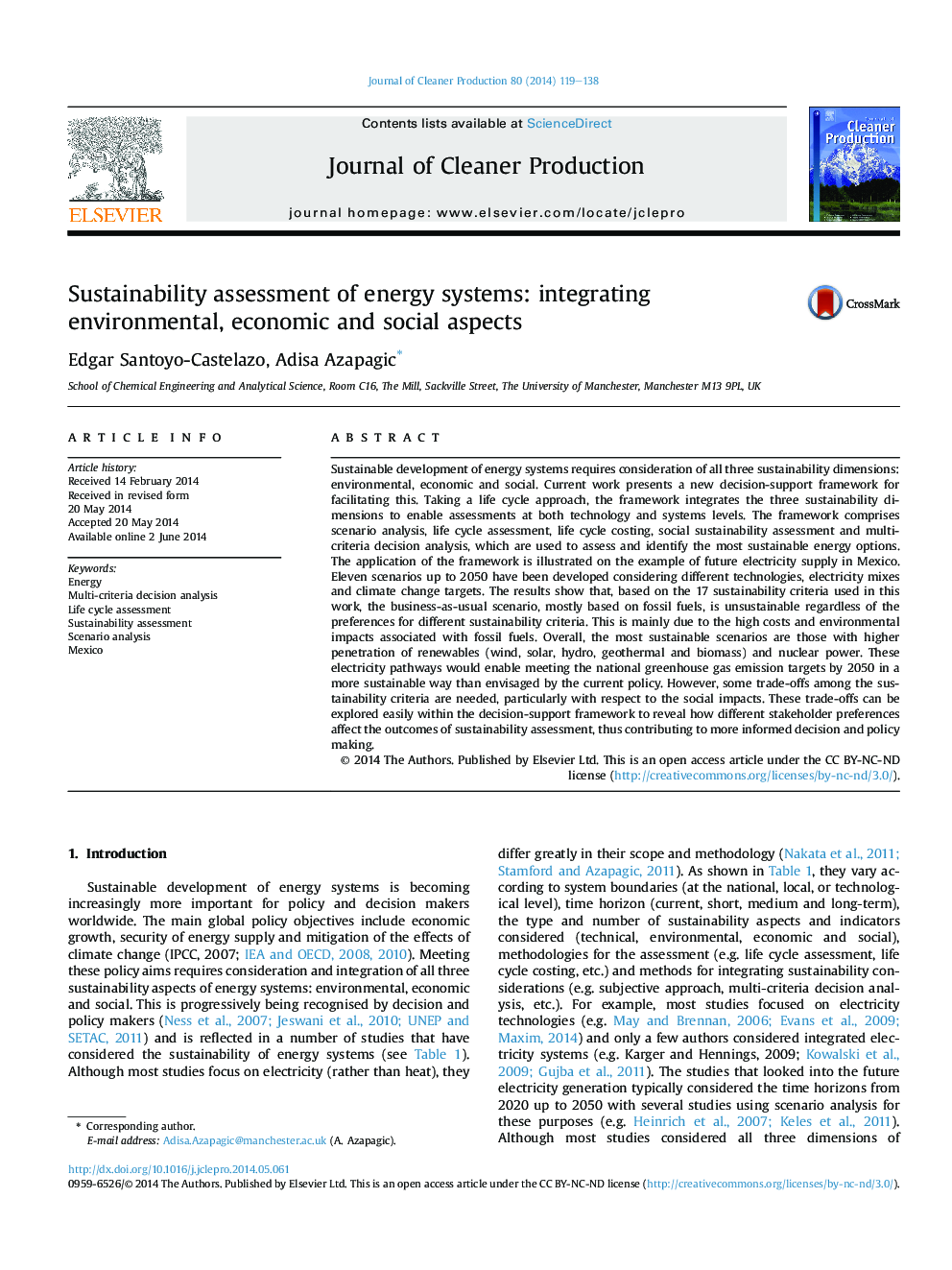| کد مقاله | کد نشریه | سال انتشار | مقاله انگلیسی | نسخه تمام متن |
|---|---|---|---|---|
| 8105948 | 1522166 | 2014 | 20 صفحه PDF | دانلود رایگان |
عنوان انگلیسی مقاله ISI
Sustainability assessment of energy systems: integrating environmental, economic and social aspects
ترجمه فارسی عنوان
ارزیابی پایداری سیستم های انرژی: ادغام جنبه های زیست محیطی، اقتصادی و اجتماعی
دانلود مقاله + سفارش ترجمه
دانلود مقاله ISI انگلیسی
رایگان برای ایرانیان
کلمات کلیدی
انرژی، تجزیه و تحلیل تصمیم چند معیاره، ارزیابی چرخه حیات، ارزیابی پایداری، تجزیه و تحلیل سناریو، مکزیک،
ترجمه چکیده
توسعه پایدار سیستم های انرژی مستلزم توجه به سه بعد پایداری: محیط زیست، اقتصادی و اجتماعی است. در حال حاضر، چارچوب حمایت جدید تصمیم گیری برای تسهیل این امر ارائه می شود. با استفاده از رویکرد چرخه عمر، چارچوب سه بعد پایداری را به منظور ارزیابی در سطوح تکنولوژی و سیستم های ادغام می کند. این چارچوب شامل تجزیه و تحلیل سناریو، ارزیابی چرخه زندگی، هزینه های چرخه زندگی، ارزیابی پایداری اجتماعی و تجزیه و تحلیل تصمیم گیری چند معیاره است که برای ارزیابی و شناسایی گزینه های پایدار انرژی استفاده می شود. استفاده از این چارچوب بر روی مثال عرضه برق آینده در مکزیک نشان داده شده است. 11 سناریو تا سال 2050 با توجه به فن آوری های مختلف، مخلوط برق و اهداف تغییرات آب و هوایی طراحی شده است. نتایج نشان می دهد که براساس 17 معیار پایداری که در این کار استفاده می شود، سناریوی کسب و کار معمول، که عمدتا بر اساس سوخت های فسیلی است، صرف نظر از ترجیحات معیارهای پایداری، بی ثبات است. این عمدتا به دلیل هزینه های بالا و اثرات زیست محیطی مرتبط با سوخت های فسیلی است. به طور کلی، پایدار ترین سناریوهایی هستند که نفوذ بیشتری از انرژی های تجدید پذیر (باد، خورشیدی، آب، زمین گرمایی و زیست توده) و انرژی هسته ای دارند. این راه های برق می تواند اهداف انتشار گازهای گلخانه ای ملی تا سال 2050 را به شیوه ای پایدارتر از پیش بینی های سیاست فعلی برساند. با این حال، در میان معیارهای پایداری بایستی تعدادی از موارد، مخصوصا در رابطه با اثرات اجتماعی، مورد نیاز باشد. این ترکیبات را می توان به آسانی در چارچوب چارچوب پشتیبانی تصمیم بررسی کرد تا نشان دهد که چگونه اختیارات ذینفعان مختلف بر نتایج ارزیابی پایداری تاثیر می گذارد، بنابراین به تصمیم گیری و سیاست گذاری آگاهانه تر کمک می کند.
موضوعات مرتبط
مهندسی و علوم پایه
مهندسی انرژی
انرژی های تجدید پذیر، توسعه پایدار و محیط زیست
چکیده انگلیسی
Sustainable development of energy systems requires consideration of all three sustainability dimensions: environmental, economic and social. Current work presents a new decision-support framework for facilitating this. Taking a life cycle approach, the framework integrates the three sustainability dimensions to enable assessments at both technology and systems levels. The framework comprises scenario analysis, life cycle assessment, life cycle costing, social sustainability assessment and multi-criteria decision analysis, which are used to assess and identify the most sustainable energy options. The application of the framework is illustrated on the example of future electricity supply in Mexico. Eleven scenarios up to 2050 have been developed considering different technologies, electricity mixes and climate change targets. The results show that, based on the 17 sustainability criteria used in this work, the business-as-usual scenario, mostly based on fossil fuels, is unsustainable regardless of the preferences for different sustainability criteria. This is mainly due to the high costs and environmental impacts associated with fossil fuels. Overall, the most sustainable scenarios are those with higher penetration of renewables (wind, solar, hydro, geothermal and biomass) and nuclear power. These electricity pathways would enable meeting the national greenhouse gas emission targets by 2050 in a more sustainable way than envisaged by the current policy. However, some trade-offs among the sustainability criteria are needed, particularly with respect to the social impacts. These trade-offs can be explored easily within the decision-support framework to reveal how different stakeholder preferences affect the outcomes of sustainability assessment, thus contributing to more informed decision and policy making.
ناشر
Database: Elsevier - ScienceDirect (ساینس دایرکت)
Journal: Journal of Cleaner Production - Volume 80, 1 October 2014, Pages 119-138
Journal: Journal of Cleaner Production - Volume 80, 1 October 2014, Pages 119-138
نویسندگان
Edgar Santoyo-Castelazo, Adisa Azapagic,
